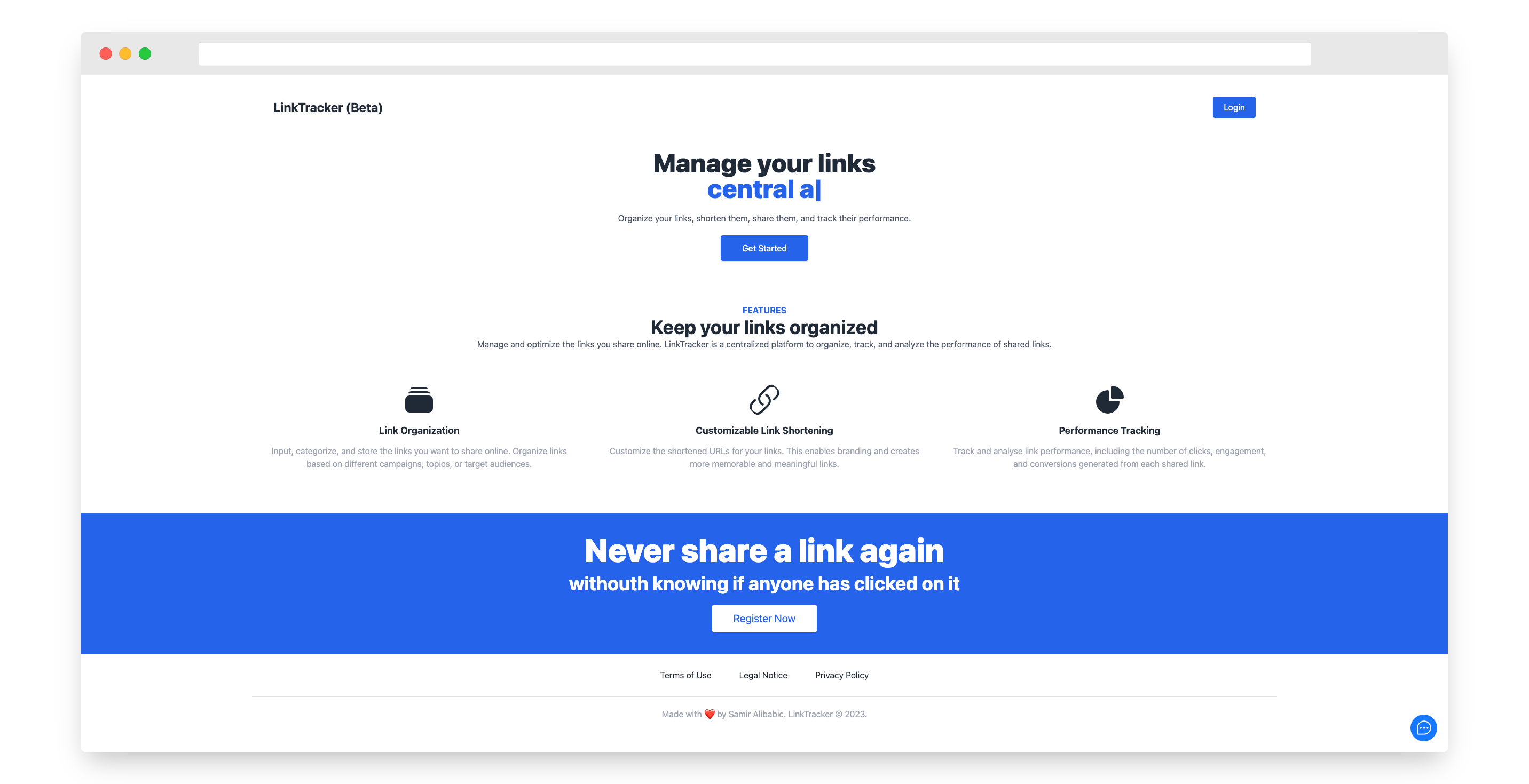How I Built a Link Management Tool MVP in 4 Weeks with the Help of AI
 Samir Alibabic
Samir Alibabic
As an indie developer, you have the freedom to explore your creativity, but the challenge lies in selecting an idea that's not only viable but also achievable when working solo. Ideally, it should be something that aligns with your interests, to keep you motivated and focused.
I've often found myself overwhelmed by the sheer amount of work it takes to bring a concept to life, from brainstorming ideas to coding and finally getting it into the hands of users. Not to mention the knowledge and skills you have to acquire to be able to implement all of it.
Luckily, in 2023, AI is advanced enough to assist us and speed up the whole process. Let's explore together how it can help.
Brainstorming Ideas
I had a few years of experience working as a software developer, and my interests spanned across tech, finance, aviation, space, and gaming. The vastness of these interests left me pondering over the right niche.
To tackle this, I turned to ChatGPT for assistance. The goal was to find a project that I could develop quickly, test in the real world, and iterate on as needed.
The prompts were engineered in such a way as to take into account my background, personal interests, knowledge, and skills. The AI considered factors like market trends, user needs, and competition, which helped narrow down the possibilities.
The first idea AI came up with, was an educative 👩🎓 financial 💸 simulation game, FinSim 🏦.
Money, money, money,
Must be funny
I found the idea appealing, but at the same time, I was a little skeptical about whether I could pull this off. It was supposed to be educational, but I wasn't an expert and I didn't have time to become one. It was just too much, even with AI as an assistant. So I said:
Let’s focus on something minimal, which could potentially be used or needed by lots of people online, a web or mobile app, that can be created (at least MVP) in a few weeks.
Selecting a Viable Idea
And that's how LinkTracker was born. It's a link shortener, management, and analytics tool, in the form of a web application designed to help users manage, optimize, and track the performance of the links they share online. This idea had several advantages:
Relevance: Link management is a ubiquitous need, not limited to any specific industry or niche. Anyone who shares links online could benefit from it. (Mistake #1)
Passive Income Potential: While the initial development required effort, the tool had the potential to generate almost passive income through subscription plans or ad placements. (Mistake #2)
Interest Alignment: The project aligned with my interests in tech and web development, making it a project I could stay passionate about.
Defining the MVP
The focus was on delivering fast, following a Lean approach to validate ideas quickly. With the idea in place, the next step was to define the Minimum Viable Product (MVP). AI played a crucial role in this phase as well. It assisted in creating a structured roadmap for development and prioritizing features based on their importance and feasibility.
AI-Driven Feature Definition
Link Shortening: One of the core features of LinkTracker is the ability to quickly shorten links and copy them to the clipboard.
Tag and Category Management: AI suggested a feature for adding tags and categories to links. Users could either create new tags and categories on the fly or select from existing ones, simplifying link organization.
Automatic Title Generation: To enhance user experience, AI suggested generating titles for links based on the linked webpage's title.
Timestamps: The fields like "created by," "created at," and "modified at" were populated without manual intervention.
This is a simple example, and after some research and googling, everybody can come up with some features. But, remember, this is a LLM neural network, which was fed vast amounts of data, on any topic, and it always gives the most relevant topics.
I like to think of it like a tag cloud, where tags are whole, dynamically generated paragraphs of text, and you can tap into this knowledge cloud without doing the research yourself.
Selecting the Right Technologies
Choosing the right technologies is crucial in any development project. I opted for a combination of technologies that suited the project's requirements and my familiarity with them.
Frontend: Instead of starting from scratch, I decided to use a SaaS starter kit called Nextacular, built on Next.js. It provided a multi-tenant app structure with Prisma, TailwindCSS, and Stripe integration out of the box. For UI components, I opted for Ant Design, a design system that had most of the components I needed.
Backend: To streamline backend development, I utilized Next.js's ability to create REST APIs. I also deployed the application on Vercel, ensuring an efficient developer experience. For the database, I went with Supabase, a Backend-as-a-Service solution built on PostgreSQL. Prisma served as the ORM to interact with the database.
AI Assistance: Amazon CodeWhisperer was instrumental in writing code snippets, especially in areas where I wasn't entirely familiar with the technologies involved. ChatGPT played a pivotal role in proposing features for the MVP, defining the backlog, and setting sprint goals. The AI was adept at managing the project, while I guided it to better fit my needs and schedule.
Weekly Progression
The development process was divided into weekly sprints. Here's a summary of the weekly progression:
Week 1: Infrastructure and Database Setup
Set up a local development environment and version control
Configure and adapt Nextacular for my use case
User registration and authentication via SendGrid (E-Mail)
Create a database schema to store link-related information
Week 2: UI and Core Features
Build the user interface for managing and organizing links
Implement link-shortening functionality to generate shortened URLs
Deployment to Vercel and CI/CD setup
Week 3: Link Performance Analytics
Update database schema to capture and store performance data
Enhance UI with analytical data: browsers, devices, referrers, and countries
Week 4: Legal compliance, Product Launch and User Feedback
Drafting and publishing legal documents
Launching the MVP into a public beta
Gathering user feedback and implementing improvements
Costs
When embarking on the journey of product development and idea validation, one critical element to consider is cost management. It's paramount to keep expenses to a minimum, especially before your product starts generating revenue. The pitfalls of ignoring this aspect are evident in the stories of numerous indie builders and startups that faced financial struggles, and, in some cases, even accumulated debt due to uncontrolled costs.
Now, let's talk about LinkTracker's costs. How much does it cost to run this platform? Is it $10 per month, $150 per month, or perhaps a whopping $2500 per month? The answer may surprise you:
$0 per month.
Yes, you read that correctly – zero dollars for hosting and maintaining a fully functional web application. The only recurring expenditure is a mere $20 per year for the domain. 😁
You might be wondering how this is possible. The secret lies in the strategic choice of technologies. If you delve a bit deeper, you'll discover that all the services employed in the LinkTracker ecosystem offer free initial tiers, which aligns perfectly with the needs and budget constraints of startups and indie developers.
Conclusion
From idea generation to feature definition, technology selection, and weekly progression, AI played a pivotal role in making the development of LinkTracker a reality in just a few weeks.
However, having another tool in your arsenal does not make you immune to making mistakes. Besides coding mistakes while using new and unknown tech, here are the two mistakes or wrong assumptions I made when selecting a viable idea:
relevance and
passive income potential
While it is true, that anybody who shares links online, can benefit from a link management tool, people rarely bother. It's only when it's their job, and it becomes tedious and cumbersome, that people turn to tools. For me, that meant, it was not for everybody and I had to find a focus group. That was mistake #1.
Whenever you build something for the people, you can be sure they will come back with questions. That means, client services and support. 🙄 Assuming it will run on autopilot without any effort was my mistake #2.
I embarked on the indie development path to fuel my growth as a software developer. In my view, every developer, regardless of their background, should work on side projects to expand their horizons.
LinkTracker's creation was an invaluable learning experience, even without immediate financial gains (yet 😈). No regrets here.
My future holds exciting prospects: crafting new ideas, enhancing product visibility, networking with industry leaders, and soaking up knowledge in business, marketing, sales, startups, and cutting-edge tech.
AI has revolutionized development, making complex tasks more manageable. Whether you're an aspiring indie developer or someone with a great idea, consider AI's potential to supercharge your project.
Subscribe to my newsletter
Read articles from Samir Alibabic directly inside your inbox. Subscribe to the newsletter, and don't miss out.
Written by

Samir Alibabic
Samir Alibabic
I build software. Started with Basic on C64 📟, now in JavaScript/TypeScript/Java 👨💻 ecosystem. Interested in Python, Go, Rust. 🥷